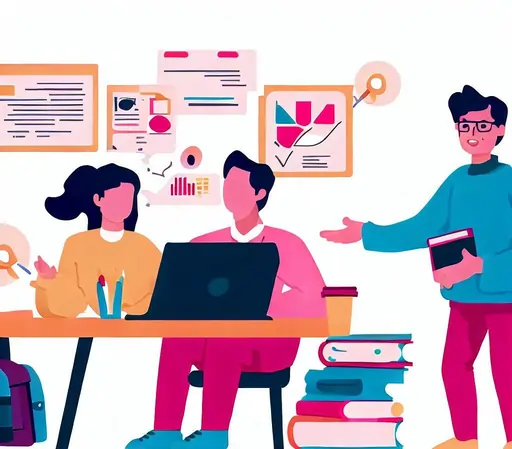Effective Revision Techniques for Visual Learners

Understanding Visual Learners
Before delving into the revision techniques tailored for visual learners, it's essential to understand their characteristics and learning preferences.

Visual learners possess a unique set of cognitive strengths that enable them to interact with information in ways that other learning styles might not. Their learning preferences are rooted in their intrinsic response to visual stimuli, and these preferences play a pivotal role in their ability to process, understand, and retain new information effectively.
Visual learners often exhibit the following traits:
- Strong Preference for Visual Aids: Visualizing Concepts for Better Comprehension
- Spatial Learning: Navigating the World of Relations and Context
- Imaginative Mindset: Crafting Mental Images for Enhanced Retention
- Colour Sensitivity: Enhancing Memory Through Color Association
- Sketching and Doodling: Transforming Idle Moments into Learning Opportunities
- Mind Mapping: Interconnecting Ideas for a Holistic View
Visual learners exhibit a strong inclination towards information that is presented through visual aids. These aids encompass a wide spectrum, ranging from graphs and charts that showcase quantitative data in a visually appealing manner, to diagrams that visually dissect complex structures or processes. These visual representations serve as a bridge between abstract concepts and tangible mental images, allowing visual learners to decode and comprehend the material more effortlessly. For instance, when faced with intricate scientific phenomena, a visual learner might find it easier to grasp the underlying mechanisms by studying a well-constructed diagram that illustrates each step of the process.
The spatial learning ability of visual learners is a fascinating aspect of their cognitive style. They excel in understanding spatial relationships, which means they can mentally manipulate and retrace visual patterns to recall information. This skill extends beyond traditional rote memorization, as it allows visual learners to create a mental map of interconnected ideas and concepts. In subjects like geography or anatomy, visual learners can excel by envisioning landscapes, body structures, or interconnections between geographical regions, thus enhancing their ability to remember and comprehend complex systems.
Visual learners have an innate imaginative mindset that enables them to construct vivid mental images. This imaginative ability facilitates memory retention by providing a framework to attach new information to existing mental constructs. When visual learners are exposed to a new concept, they can conjure a mental image that encapsulates the essence of that idea. This image then acts as a memory hook, allowing them to recall the associated information with greater ease. For example, when learning about historical events, a visual learner might visualize key moments as if they were scenes from a movie, helping them reconstruct timelines and historical narratives.
Colour sensitivity is another intriguing facet of visual learners' cognitive makeup. Colours have the power to evoke emotions, trigger memories, and enhance overall engagement. Visual learners can harness this sensitivity by assigning specific colours to different topics, categories, or concepts. The act of associating the information with distinct colours enables them to create a mnemonic framework that aids in memory recall. By relying on colour-coded notes or highlighting essential points with vibrant hues, visual learners establish a visual hierarchy that guides their attention towards key details, leading to more efficient studying and retention.
Visual learners often find themselves doodling or sketching while listening to lectures or engaging in discussions. Contrary to misconceptions that doodling signifies distraction, this activity plays a pivotal role in aiding their concentration and information retention. Doodling allows visual learners to channel their excess mental energy into visual representations that correspond to the subject matter. By doing so, they are actively encoding the information in a way that aligns with their learning style. For instance, during a biology lecture, a visual learner might doodle intricate cellular structures, thus embedding the lesson's content in their memory through visual expression.
One of the hallmark strengths of visual learners is their proficiency in creating mind maps. Mind maps are visual representations that organize ideas, concepts, and information in a structured and interconnected manner. This technique mirrors their natural thought processes, as visual learners tend to approach learning by exploring relationships and connections. By visually clustering related concepts, drawing connecting lines, and employing colour codes, visual learners craft an organized framework that encapsulates the complexity of the subject matter. This not only aids in information retention but also fosters a deeper understanding of how various components of a topic interrelate.
Effective Revision Techniques for Visual Learners
Visual learners, in particular, possess a distinctive cognitive profile that sets them apart from their peers. Their heightened sensitivity to visual stimuli provides them with a unique advantage when it comes to absorbing, comprehending, and retaining information. In this section, we delve into a range of potent revision techniques tailor-made to cater to the strengths of visual learners, ensuring their academic journey is not only productive but also engaging and rewarding.
- Mind Mapping: A Web of Clarity
- Flashcards with Visuals: Bite-sized Knowledge
- Colour-Coded Notes: The Power of Chromatics
- Visual Summaries: Condensing Complexity
- Interactive Learning: Video Tutorials and Animations
- Graphs and Charts: Quantitative Clarity
- Storyboarding: Visualizing Concepts
- Analogies and Metaphors: Relating Through Images
- Visualization Exercises: Mental Rehearsal
- Collaborative Study: Visual Exchange
Mind mapping is a powerful technique that visual learners can exploit to organize complex information. Start with a central idea and branch out into related concepts. This technique mirrors the way visual learners naturally think and encourages creativity. Use colours, symbols, and images to make the mind map more engaging and memorable.
Flashcards are a tried-and-true revision tool, and visual learners can supercharge their effectiveness by adding images to the mix. Pair key terms with relevant images on one side and explanations on the other. This technique leverages both the visual and textual aspects of learning, aiding memory recall.
A color is a potent tool for visual learners. Assign specific colours to different topics or concepts. When reviewing notes, the colours act as triggers, aiding in the swift retrieval of information. This technique can turn ordinary notes into a vibrant and engaging study resource.
Create visual summaries of lengthy texts or chapters. Convert paragraphs into diagrams or flowcharts, capturing the main ideas and their relationships. This technique simplifies complex information into easily digestible visuals, enhancing comprehension and retention.
Leverage the wealth of educational videos and animations available online. Visual learners often find concepts easier to understand when presented in a dynamic visual format. Platforms like YouTube, Khan Academy, and Coursera offer an array of video tutorials that cater to various subjects and learning levels.
For subjects involving data and statistics, visual learners can excel by creating their own graphs and charts. Transforming numerical data into visual representations aids understanding and memory. Tools like Microsoft Excel and Google Sheets make this process accessible.
Storyboarding, commonly used in film and design, can be adapted for educational purposes. Break down complex processes into a sequence of visual panels. This technique is especially effective for subjects that involve step-by-step procedures or historical events.
Visual learners benefit from associating new information with familiar images or concepts. Analogies and metaphors create mental bridges between the known and the unknown. This technique aids comprehension and retention by establishing connections in the mind.
Encourage visual learners to close their eyes and visualize concepts as vivid mental images. This technique is particularly useful for subjects that involve sequences, like biological processes or historical timelines. Mental rehearsal enhances memory recall during exams.
Engage in study groups or partnerships where you can share and discuss visual aids. Explaining concepts to peers through visuals not only reinforces your understanding but also exposes you to different perspectives and approaches.
Conclusion
In the dynamic landscape of education, where individual learning styles shape the way knowledge is absorbed and applied, visual learners stand out with their remarkable ability to harness the power of visuals for enhanced comprehension and retention. By embracing an array of effective revision techniques such as mind mapping, visual summaries, and colour-coded notes, visual learners can transform their study routine into a dynamic and engaging experience. As they unlock the potential of their unique cognitive strengths, visual learners pave the way for academic success and a lifelong journey of learning that is as vibrant and vivid as the visuals they hold dear.